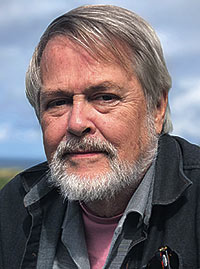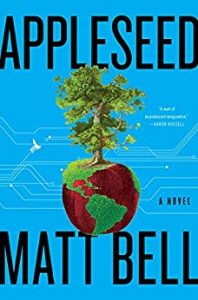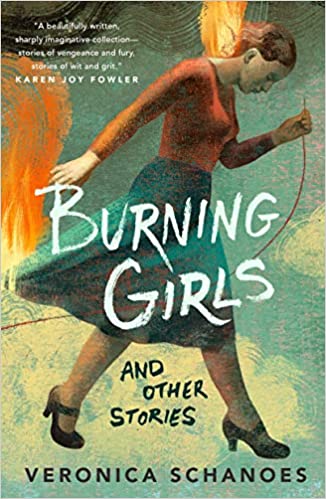The Year in Review 2021 by Gary K. Wolfe

It doesn’t seem to ever go away. It spreads, mutates, develops new strains, infects every age group, and sometimes seems immune to immunization. Its symptoms may range from the severe to the indifferent. Even if you think you’re safe from it, you might occasionally need a booster shot. By now, it’s become an accepted part of the fabric of modern life.
I’m talking about SFF, of course. Or whatever you want to call it – fantastika, metagenre, supergenre, or just the old familiar strains of science fiction, fantasy, and horror. And, like it does every year, it offered us some pretty impressive boosters in 2021. (OK, I realize my metaphor is falling apart here. The disease is not the treatment. Although with SFF, maybe it is.)
Having just completed a ridiculous 30 years of writing for Locus, it occurred to me to revisit a question I posed in my first year-in-review column way back in 1992, when all we had to worry about was something called the Beijing flu (I had to look that up, and I’m pretty sure we wouldn’t call it that today). The question was this: is SFF really making any progress? Is it getting any better, or simply covering its greatest hits in new arrangements? Those questions, in turn, were prompted by an 1853 essay titled ‘‘The Progress of Fiction as an Art’’, sometimes attributed to George Eliot, which seemed to suggest that, like science or technology, fiction advances from a primitive to a more advanced condition – the loony pleasures of the Gothic novel giving way to the subtleties of Jane Austen and eventually to the pinnacle of achievement in – surprise! – dense Victorian novels like those of George Eliot. My answer at the time was that – well, that these are basically stupid questions, and they’re especially stupid if we’re going to try measuring progress on a year-by-year or novel-by-novel basis in these annual review columns.
 It’s not so stupid, however, if we ask whether progress can be made in the SFF community or the publishing industry. That 1992 essay featured plenty of still-familiar names – Kim Stanley Robinson, Connie Willis, Joe Haldeman, Greg Bear, Geoff Ryman, Orson Scott Card, Neal Stephenson – and a few novels which have since become classics of a sort, like Snow Crash, Doomsday Book, and Red Mars. But the sole non-English science fiction novel was a much-delayed translation of Elisabeth Vonarburg’s 1981 French-language The Silent City from Canada, and the only example of what we’d now call BIPOC was the Chicano writer Ernest Hogan’s High Aztech. This year’s list, by contrast (and these are only the ones I read) includes authors from China, South Korea, Bangladesh, Malaysia, India, Sweden, Israel, and Pakistan, as well as writers of Nigerian or Vietnamese descent. One of the most consistently interesting anthologies of the year was Tarun K. Saint’s The Gollancz Book of South Asian Science Fiction, Volume Two, which cast a somewhat wider net than the first volume in its effort to define a ‘‘new wave’’ of South Asian SFF.
It’s not so stupid, however, if we ask whether progress can be made in the SFF community or the publishing industry. That 1992 essay featured plenty of still-familiar names – Kim Stanley Robinson, Connie Willis, Joe Haldeman, Greg Bear, Geoff Ryman, Orson Scott Card, Neal Stephenson – and a few novels which have since become classics of a sort, like Snow Crash, Doomsday Book, and Red Mars. But the sole non-English science fiction novel was a much-delayed translation of Elisabeth Vonarburg’s 1981 French-language The Silent City from Canada, and the only example of what we’d now call BIPOC was the Chicano writer Ernest Hogan’s High Aztech. This year’s list, by contrast (and these are only the ones I read) includes authors from China, South Korea, Bangladesh, Malaysia, India, Sweden, Israel, and Pakistan, as well as writers of Nigerian or Vietnamese descent. One of the most consistently interesting anthologies of the year was Tarun K. Saint’s The Gollancz Book of South Asian Science Fiction, Volume Two, which cast a somewhat wider net than the first volume in its effort to define a ‘‘new wave’’ of South Asian SFF.
That’s progress, or at least the beginning of progress.
Like every reader, those of us who write reviews on a regular basis also have piles of to-read books we simply didn’t get to; hence the usual disclaimer that I can’t comment on some fine and/or popular books of 2021, including titles by Tade Thompson, Andy Weir, Monica Byrne, Adrian Tchaikovsky, Joanne Harris, Usman Malik, and many others. Their exclusion from this discussion is in no way a critical judgment; like many other readers of a determinedly paranoid bent, I manage to end every year with the insidious fear that I may well have completely overlooked, or never even heard of, the one SF masterpiece that we’ll still be talking about 30 years hence. My apologies to the author of that masterpiece. You know who you are.
Of the more-or-less traditional SF novels, the outstanding space opera of the year was Arkady Martine’s A Desolation Called Peace, the second volume in her Teixcalaanli series, which broke new ground while recalling the morally complex traditions of Le Guin and Cherryh. One of the handful of YA titles I saw, Charlie Jane Anders’s Victories Greater than Death, celebrated an even older tradition of space opera, with its diverse cast of bright kids helping save the universe, helping bring the spirit of the star-smashing pulps and the Heinlein juveniles into the age of gender awareness. Certainly the oddest space opera, and perhaps the most inventive, was Adam Roberts’s somewhat cerebral Purgatory Mount, with its giant alien artifact resembling Dante’s purgatory, its class-stratified starship, and – most surprising of all – its portrait of young hackers in a near-future dystopia which only gradually links to the space opera plot. Other familiar SF themes also came in for some creative revisionist thinking, like the machine revolt of S.B. Divya’s provocative Machinehood, the clone conundrums of Sarah Gailey’s The Echo Wife (which works more effectively as a character-based thriller than as extrapolation), and the postapocalypic, post-climate disaster setting of Claire North’s Notes from the Burning World, which at its best evoked such classics as A Canticle for Leibowitz. Daryl Gregory even directly alluded to an SF classic in his thoroughly enjoyable The Album of Dr. Moreau, bringing Wells’s uplifted animals into a manic locked-room mystery bizarrely involving a K-pop style boy band.
 One of the more ambitious mainstream crossovers was Matt Bell’s Appleseed, with its tripartite setting of the 18th century American frontier, a near-future climate catastrophe, and a distant future lonely robot, as well as its occasionally uncertain blend of genres (the Johnny Appleseed figure is a faun, but the bits set in the future are pure SF). Climate catastrophe has by now become as familiar a part of the SF repertoire as space opera or time travel, and it’s increasingly a challenge to make it seem new. Catherynne Valente’s inventive strategy was to push it to nearly surreal effects – The Past is Red is mostly set in a scavenger society aboard the great Pacific garbage patch – and to show it to us through the viewpoint of an irrepressible optimist, Tetley Abednego, who remains my favorite SF character of the year (even if we did meet her a few years earlier in the novelette that forms the first part of the book). Speaking of characters – or SF novels that draw their power as much from the characters as the ideas – I was impressed by the insightful family dynamics of Sarah Pinsker’s We Are Satellites, which also involves some solid ideas about the moral questions raised by human enhancement, and the lively alliances of web-savvy young people who more or less save the world in Naomi Kritzer’s Chaos on CatNet (her higher-stakes sequel to Catfishing on Catnet), and Saad Hossain’s characteristically hilarious Cyber Mage, which continues his shrewd exploration of a nano-drenched, AI-managed future Bangladesh. (It wasn’t marketed as YA, as far as I know, but as I’ve argued before, it’s not a distinction that necessarily means much to SF readers). The most original settings for SF novels were the wind-ravaged northern Nigeria of Nnedi Okorafor’s powerful thriller Noor and the ancient walled city of Sumer in Horizon, Gautam Bhatia’s sequel to last year’s The Wall, which opens up the earlier novel in promising ways.
One of the more ambitious mainstream crossovers was Matt Bell’s Appleseed, with its tripartite setting of the 18th century American frontier, a near-future climate catastrophe, and a distant future lonely robot, as well as its occasionally uncertain blend of genres (the Johnny Appleseed figure is a faun, but the bits set in the future are pure SF). Climate catastrophe has by now become as familiar a part of the SF repertoire as space opera or time travel, and it’s increasingly a challenge to make it seem new. Catherynne Valente’s inventive strategy was to push it to nearly surreal effects – The Past is Red is mostly set in a scavenger society aboard the great Pacific garbage patch – and to show it to us through the viewpoint of an irrepressible optimist, Tetley Abednego, who remains my favorite SF character of the year (even if we did meet her a few years earlier in the novelette that forms the first part of the book). Speaking of characters – or SF novels that draw their power as much from the characters as the ideas – I was impressed by the insightful family dynamics of Sarah Pinsker’s We Are Satellites, which also involves some solid ideas about the moral questions raised by human enhancement, and the lively alliances of web-savvy young people who more or less save the world in Naomi Kritzer’s Chaos on CatNet (her higher-stakes sequel to Catfishing on Catnet), and Saad Hossain’s characteristically hilarious Cyber Mage, which continues his shrewd exploration of a nano-drenched, AI-managed future Bangladesh. (It wasn’t marketed as YA, as far as I know, but as I’ve argued before, it’s not a distinction that necessarily means much to SF readers). The most original settings for SF novels were the wind-ravaged northern Nigeria of Nnedi Okorafor’s powerful thriller Noor and the ancient walled city of Sumer in Horizon, Gautam Bhatia’s sequel to last year’s The Wall, which opens up the earlier novel in promising ways.
It was a strong year for fantasy novels, even given my relative ignorance of the large-canvas epics that many people think of as core fantasy. Early in the year, On Fragile Waves, the first novel from the wildly talented E. Lily Yu, provided a powerful and heartbreaking account of the lives of a family of Afghan refugees – a topic that became even more urgent later in the year. It was somewhat restrained and judicious in its use of fantasy elements, as was The Shipbuilder of Bellfairie, which is essentially the novel many of us have hoped for from Mary Rickert, and which gave me my other favorite character of the year, the haunted and lonely giant Quark, returning to his equally haunted hometown in search of a missing father. A haunted, or possibly cursed, family was also at the center of Daryl Gregory’s Revelator, which took on the aspect of folk horror with its effective use of its eastern Tennessee setting. Similarly, the Malaysian setting of Zen Cho’s Black Water Sister was crucial to the effectiveness of a tale that again subsumed its supernatural fireworks to an affecting family portrait. My favorite fairy tale redaction of the year, Alix E. Harrow’s A Spindle Splintered, gained much of its strength from its counterpointing of real-world hazards with a clever bibliofantasy drawn from versions of Sleeping Beauty.
But by far the most bizarre and memorable settings were those of Karin Tidbeck’s The Memory Theatre and Lavie Tidhar’s The Escapement, the former beginning in a hidden polder full of decadent immortals, but expanding into a magical Sweden that abuts our own world, the latter in a shifting mythic landscape resonant of spaghetti-westerns and quest narratives, but with lots of weird clowns along with the gunslingers. Tidhar’s other novel of the year, The Hood, moved his recasting of British mythology from the Arthurian era up to the medieval Robin Hood legends, though Robin himself was probably the least interesting of a colorful cast of manipulative characters. The most ingenious management of setting, however, belonged to Nghi Vo, who basically set her brilliant genderqueer revisionist fantasy The Chosen and the Beautiful within the spaces of F. Scott Fitzgerald’s The Great Gatsby. Alternate histories always make for intriguing settings, and few were more fun than P. Djèlí Clark’s A Master of Djinn, which uses its version of a transformed 1912 Cairo to make pointed critiques of colonialism and appropriation, as well as to set off some spectacular fireworks. Finally, in No Gods, No Monsters Cadwell Turnbull offers what would seem to be a near-future SF scenario in which something called the Fracture has released all the hidden monsters back into the world, in a tale which grows into a powerful parable of outsiderdom.
2021 was also a strong year for story collections. Starting at the harder, near-future end of the spectrum, Kai-Fu Lee & Chen Qiufan’s AI 2041: Ten Visions for Our Future combined Lee’s speculative essays about aspects of AI with Chen’s stories, which turned out to be not nearly as programmatic as the book’s conceit might imply. The short fiction of Korean writer Kim Bo-Young appeared in not one but two collections, I’m Waiting for You and Other Stories, translated by Sophie Bowman and Sung Ryu, and On the Origin of Species and Other Stories, translated by Joungmin Lee Comfort and Sora Kim-Russell, with tales that ranged from traditional hard SF to cosmological myths. The always tricky, always rewarding Nina Allan gave us The Art of Space Travel, with its near-classic title story and others that demonstrate her spider-like talent for weaving tales into a web that seems greater than its parts.
 But what seemed especially significant about 2021 were the major authors who produced their first short fiction collections (except for a few earlier chapbooks). Kelly Robson’s Alias Space demonstrated a remarkable versatility ranging from the comic historical ‘‘The Waters of Versailles’’ to the extremely creepy ‘‘A Human Stain’’ to a touching series about queer street theater in Toronto. Charlie Jane Anders, interestingly, shows a similar kind of range in Even Greater Mistakes; her seriocomic Rock Manning dystopian tales are countered by the chilling ‘‘Don’t Press Charges and I Won’t Sue’’ and a series about Bay Area gay life that moves into an increasingly dire future. Veronica Schanoes’ Burning Girls and Other Stories demonstrates a mastery of both historical settings and literary fairytale traditions, ranging from old anti-Semitic tales and the career of Lewis Carroll to punk rock, but nowhere more effective than in her haunting title novella, centered around turn-of-the-century immigrant factory workers. Zen Cho’s Spirits Abroad might not at first seem like a 2021 book – it won the Crawford Award back in 2015 – but the Small Beer Press edition includes more than a dozen additional stories, showcasing Cho’s by now well-known gift for comedy – here involving some recalcitrant dragons, helpful talking cats, and even talking goldfish – but also her mastery of Malaysian folk horror and even a bit of moon-colony SF. Finally, it’s always a pleasure to discover a new writer – or at least one I was previously unfamiliar with, and Brenda Peynado’s The Rock Eaters introduced me to another writer straddling that increasingly tenuous divide between genre and small-press litfic. Peynado effortlessly ranges from the SFnal ‘‘The Kite Maker’’, with its dragonfly-like alien visitors, to too-believable nightmares in which school shootings or child drownings are an accepted cost of modern life, to a plague-ridden world where everyone retreats into their own private capsules. Peynaud is especially adept at portraying the plight of different kinds of outsiders.
But what seemed especially significant about 2021 were the major authors who produced their first short fiction collections (except for a few earlier chapbooks). Kelly Robson’s Alias Space demonstrated a remarkable versatility ranging from the comic historical ‘‘The Waters of Versailles’’ to the extremely creepy ‘‘A Human Stain’’ to a touching series about queer street theater in Toronto. Charlie Jane Anders, interestingly, shows a similar kind of range in Even Greater Mistakes; her seriocomic Rock Manning dystopian tales are countered by the chilling ‘‘Don’t Press Charges and I Won’t Sue’’ and a series about Bay Area gay life that moves into an increasingly dire future. Veronica Schanoes’ Burning Girls and Other Stories demonstrates a mastery of both historical settings and literary fairytale traditions, ranging from old anti-Semitic tales and the career of Lewis Carroll to punk rock, but nowhere more effective than in her haunting title novella, centered around turn-of-the-century immigrant factory workers. Zen Cho’s Spirits Abroad might not at first seem like a 2021 book – it won the Crawford Award back in 2015 – but the Small Beer Press edition includes more than a dozen additional stories, showcasing Cho’s by now well-known gift for comedy – here involving some recalcitrant dragons, helpful talking cats, and even talking goldfish – but also her mastery of Malaysian folk horror and even a bit of moon-colony SF. Finally, it’s always a pleasure to discover a new writer – or at least one I was previously unfamiliar with, and Brenda Peynado’s The Rock Eaters introduced me to another writer straddling that increasingly tenuous divide between genre and small-press litfic. Peynado effortlessly ranges from the SFnal ‘‘The Kite Maker’’, with its dragonfly-like alien visitors, to too-believable nightmares in which school shootings or child drownings are an accepted cost of modern life, to a plague-ridden world where everyone retreats into their own private capsules. Peynaud is especially adept at portraying the plight of different kinds of outsiders.
I don’t really have the space to focus here on the various SFF efforts that movies, TV, gaming, graphic novels, and other media have undertaken with various degrees of success, except to note that in two the most high-profile examples, Dune and Foundation, the source material was SF literature of more than a half-century ago. While it’s pleasing to finally see serious efforts to bring those old classics to much wider audiences, I wonder what might happen if some of those producers were to stumble across SFF as it’s evolved in 2021. I’m sure that a few of the titles I’ve mentioned do have media options of one sort or another, but the lesson here may be that if you really want to know what SFF is about in the modern world, you still need to read. It’s good for you, and it may make you immune from all sorts of things. For a little while longer, anyway.
Gary K. Wolfe is Emeritus Professor of Humanities at Roosevelt University and a reviewer for Locus magazine since 1991. His reviews have been collected in Soundings (BSFA Award 2006; Hugo nominee), Bearings (Hugo nominee 2011), and Sightings (2011), and his Evaporating Genres: Essays on Fantastic Literature (Wesleyan) received the Locus Award in 2012. Earlier books include The Known and the Unknown: The Iconography of Science Fiction (Eaton Award, 1981), Harlan Ellison: The Edge of Forever (with Ellen Weil, 2002), and David Lindsay (1982). For the Library of America, he edited American Science Fiction: Nine Classic Novels of the 1950s in 2012, with a similar set for the 1960s forthcoming. He has received the Pilgrim Award from the Science Fiction Research Association, the Distinguished Scholarship Award from the International Association for the Fantastic in the Arts, and a Special World Fantasy Award for criticism. His 24-lecture series How Great Science Fiction Works appeared from The Great Courses in 2016. He has received six Hugo nominations, two for his reviews collections and four for The Coode Street Podcast, which he has co-hosted with Jonathan Strahan for more than 300 episodes. He lives in Chicago.
This review and more like it in the February 2022 issue of Locus.
 While you are here, please take a moment to support Locus with a one-time or recurring donation. We rely on reader donations to keep the magazine and site going, and would like to keep the site paywall free, but WE NEED YOUR FINANCIAL SUPPORT to continue quality coverage of the science fiction and fantasy field.
While you are here, please take a moment to support Locus with a one-time or recurring donation. We rely on reader donations to keep the magazine and site going, and would like to keep the site paywall free, but WE NEED YOUR FINANCIAL SUPPORT to continue quality coverage of the science fiction and fantasy field.
©Locus Magazine. Copyrighted material may not be republished without permission of LSFF.






